
Geranium maderense, known as giant herb-Robert or the Madeira cranesbill, is a species of flowering plant in the family Geraniaceae, native to the island of Madeira. It is sometimes confused with another Madeira endemic, Geranium palmatum.

Ceanothus is a genus of about 50–60 species of nitrogen-fixing shrubs and small trees in the buckthorn family (Rhamnaceae). Common names for members of this genus are buckbrush, California lilac, soap bush, or just ceanothus. "Ceanothus" comes from Ancient Greek: κεάνωθος (keanōthos), which was applied by Theophrastus to an Old World plant believed to be Cirsium arvense.

Erica tetralix, the cross-leaved heath, is a species of flowering plant in the family Ericaceae, native to western Europe.

Sinningia is a genus of flowering plants in the family Gesneriaceae. It is named after Wilhelm Sinning (1792–1874), a gardener of the Botanische Gärten der Friedrich-Wilhelms-Universität Bonn. There are about 65 species of tuberous herbaceous perennials, all occurring in Central and South America, with the greatest concentration of species occurring in southern Brazil.

Sanguisorba officinalis, commonly known as great burnet, is a plant in the family Rosaceae, subfamily Rosoideae. It is native throughout the cooler regions of the Northern Hemisphere in Europe, northern Asia, and northern North America.

Cornus alba, the red-barked, white or Siberian dogwood, is a species of flowering plant in the family Cornaceae, native to Siberia, northern China and Korea. It is a large deciduous surculose (suckering) shrub that can be grown as a small tree. As a popular ornamental used in landscaping its notable features include the red stems in fall (autumn) through late winter, bright winter bark; and the variegated foliage in some cultivars, such as C. alba 'Elegantissima'. C. alba can grow to 3 m (10 ft) high, but variegated forms are less vigorous. For the brightest winter bark, young shoots are encouraged by cutting to the ground some older stems at the end of the winter, before leaves are open. The oval fruits are white, sometimes tinted blue.

Senecio macroglossus, the Natal ivy, marguerite ivy, climbing senecio or wax ivy, is a species of flowering plant in the family Asteraceae, native to southern Africa, from Zimbabwe and Mozambique to eastern South Africa.

Loasa is a genus of flowering plants in the family Loasaceae. The genus contains about 100 species native to Central and South America. Species of Loasa are prickly herbs or shrubs that have nettle-like stinging hairs. Some species of Loasa are grown as ornamental plants and are known as Chile nettle. Its flowers have five yellow petals covering united stamens and distinctive large coloured nectaries. Caiophora is a closely related genus that also has stinging hairs and is found on rocky slopes of the Andes.

Hesperantha coccinea, the river lily, or crimson flag lily, is a species of flowering plant in the iris family Iridaceae, native to Southern Africa and Zimbabwe.

Hoheria is a genus of six species of flowering plants in the family Malvaceae. All are endemic to New Zealand. The genus name is a latinization of the Māori language name, houhere. That name, as well as lacebark and ribbonwood, are often used as common names. The name lacebark comes from the lace-like fibrous inner bark layer.

Prunus incisa, the Fuji cherry, is a species of flowering plant in the family Rosaceae, which gets its scientific name from the deep incisions on the leaves. It is an endemic species in Japan and grows wild in Kantō, Chūbu and Kinki regions. It is called the Fuji cherry because it grows in particular abundance around Mount Fuji and Hakone. A dainty slow-growing, early white-flowering cherry tree, this century-old cultigen from Hondo, Japan is highly regarded as an ornamental but the wood has no industrial value. It is hardy to -20 °C, and crossed with Prunus speciosa, has yielded the cultivar Prunus 'Umineko'. It is in the ornamental section Pseudocerasus of the cherry subgenus Cerasus of the genus Prunus. Ma et al. classified it in a group with Prunus nipponica.

Salvia is the largest genus of plants in the sage family Lamiaceae, with nearly 1000 species of shrubs, herbaceous perennials, and annuals. Within the Lamiaceae, Salvia is part of the tribe Mentheae within the subfamily Nepetoideae. One of several genera commonly referred to as sage, it includes two widely used herbs, Salvia officinalis and Salvia rosmarinus.

Tradescantia spathacea, the oyster plant, boatlily or Moses-in-the-cradle, is a herb in the Commelinaceae family first described in 1788. It is native to Belize, Guatemala, and southern Mexico but widely cultivated as an ornamental and naturalized in parts of Florida, Texas, Hawaii, and various oceanic islands.

Rumohra adiantiformis, the leather fern or leatherleaf fern, is a species of fern in the wood fern family Dryopteridaceae. It has a wide distribution, mainly in the tropical Southern Hemisphere.
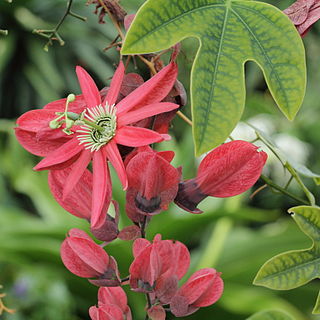
Passiflora racemosa, the red passion flower, is a species of flowering plant in the family Passifloraceae, native to Brazil. It is an evergreen climber growing to 5 m (16 ft), with simple or 3-lobed leaves to 10 cm (4 in) long, and vivid red flowers borne in summer. The flowers are 12 cm (5 in) in diameter, with purple and white coronas. They are followed by oblong green fruits.
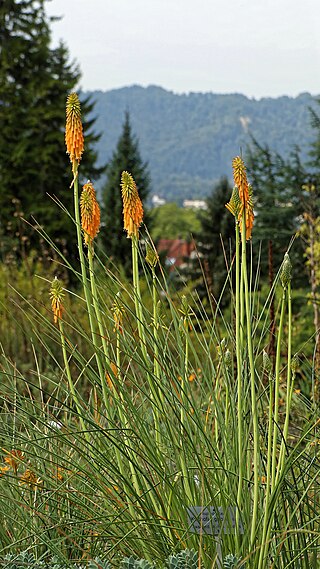
Kniphofia galpinii, called the Galpin red-hot poker, is a species of flowering plant in the genus Kniphofia, native to Eswatini and South Africa. It has gained the Royal Horticultural Society's Award of Garden Merit.
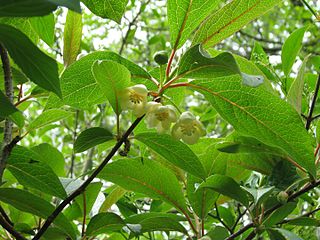
Schisandra grandiflora, called the large-flowered magnolia vine, is a species of flowering plant in the genus Schisandra, native to the Himalayas and Tibet. A deciduous, twining climber, it has gained the Royal Horticultural Society's Award of Garden Merit as an ornamental.
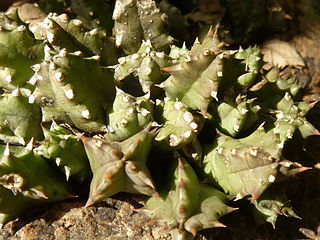
Huernia hystrix, the porcupine huernia, is a species of flowering plant in the family Apocynaceae, native to southeastern Africa. A succulent, it has gained the Royal Horticultural Society's Award of Garden Merit.

Dracaena surculosa, called the gold dust dracaena and spotted dracaena, is a species of flowering plant in the family Asparagaceae, native to west and west-central tropical Africa, from Guinea to the Republic of the Congo. Its cultivar 'Florida Beauty' has gained the Royal Horticultural Society's Award of Garden Merit.
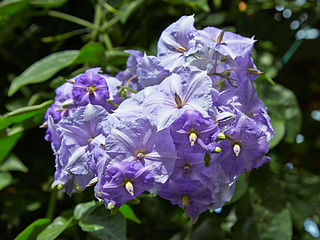
Solanum wendlandii, the giant potato creeper, potato vine, Costa Rican nightshade, divorce vine, or paradise flower, is a species of flowering plant in the family Solanaceae. It is native to Mexico, Central America, and northwest South America, and has been widely introduced as an ornamental to other tropical locales, including the Caribbean, Africa, Nepal, Java, and many islands in the Indian and Pacific Oceans. A robust vine reaching 15 ft (4.6 m), its long-lasting dark purple flowers eventually fade to white.




















